Wondering what the fantastic rainforest mammals are? You’re in the right place–these are the most diverse and interesting Amazon Rainforest mammals!
Amazon Rainforest mammals
The Amazon Rainforest is a unique place on earth.
With over 16,000 tree species, 420 mammals, 380 reptiles, 400 amphibians, 1,300 birds, and 3,000 freshwater fishes, the Amazon is home to more species of plants and animals than any other terrestrial ecosystem on the planet.
In fact, about 30 percent of the world’s species are found there.
In today’s article, I’ll talk about the 12 most impressive mammals in the Amazon Rainforest that you need to know.
From tiny to massive animals, this list of jungle mammals will give you an idea of how diverse the South American rainforest is.
Amazon mammals
1. Jaguar
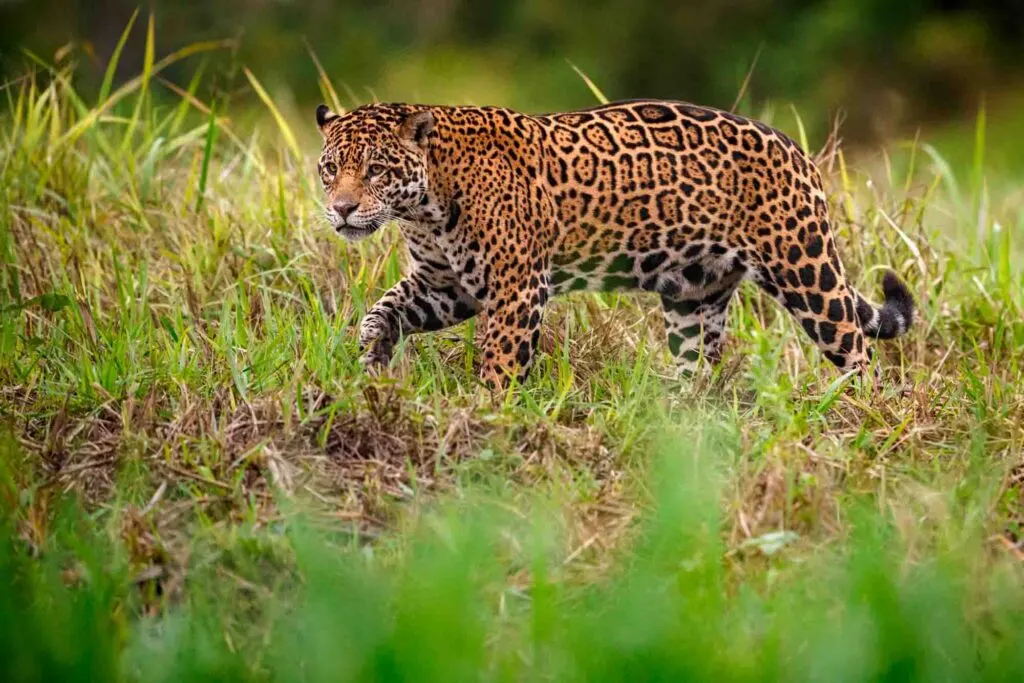
The jaguar is the most giant cat native to the American continent and the third in the world, only behind the tiger and African lion. It has a 5 to 6-feet long tan to orange body covered with black rosettes.
Besides, this big cat is often depicted as the national symbol of Brazil and is more easily found in the tropical forests of the Amazon region.
The jaguar is not afraid of getting wet or of heights. On the contrary, the biggest mammal in the Amazon Rainforest hunts in the Amazon River and climbs trees to prepare to ambush animals roaming the forest floor.
2. Giant otter
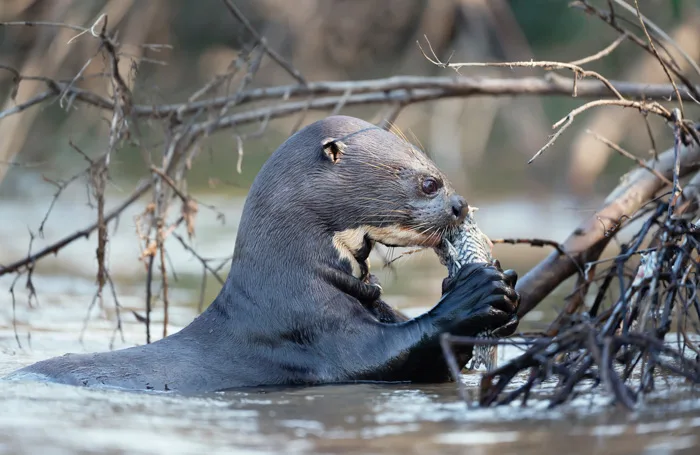
Of all the rainforest animals in Brazil, the giant otter is one of the endangered species in the Amazon Rainforest due to poaching for fur trading.
This 6-feet long mammal has a chocolate brown, sometimes reddish, very dense fur responsible for keeping the animal’s skin dry when it has its body underwater. Besides, it has a white mark on the throat and a ball-shaped head.
The giant otter is close to being an apex predator in the Amazon Basin, hunted only by the jaguar, caiman, and anaconda. This otter hunts alone or in groups, and fish, including the piranha, make up most of their diet.
3. Ocelot
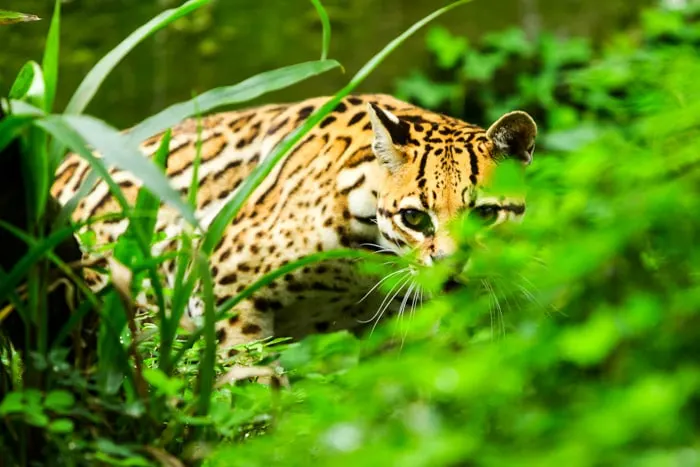
Being one of the prettiest Amazon Rainforest animals, these nocturnal cats are known for having a solitary life within a home range of as much as 4,200 soccer fields.
The ocelot is a sleek animal with a gorgeous dappled coat and is twice the average house cat’s size. Namely, its body is covered with solid black markings on a creamy, tawny, yellowish, reddish-gray, or gray fur.
Besides, this mammal lives in a wide range from the Amazon Rainforest to the north of Texas in North America. Still, habitat loss is an increasing concern among biologists.
Lastly, the ocelot feeds on monkeys, birds, reptiles, and species of fish.
4. Tufted capuchin
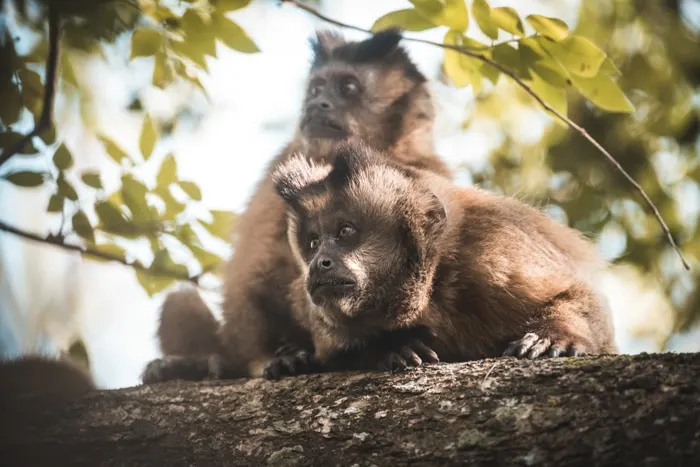
Also know as the black-capped capuchin monkey, the tufted capuchin is named after friars dressed in brown robes with hoods covering their heads. These little mammals are curious and tend to play with anything they find.
This tiny Amazon mammal species has brownish-gray fur, and its belly is a little lighter colored. Beyond that, its thick tail is as long as its body or sometimes slightly longer.
Beyond that, their diet relies heavily upon eggs, insect species, other small mammals, some species of birds, squirrels, small reptiles, nuts, and nectar. Also, tufted capuchins are a confirmed predator of the titi monkey.
5. Capybara
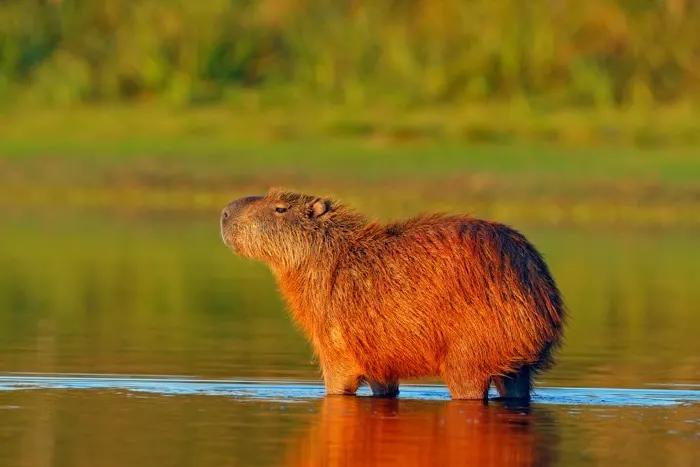
The capybara is not only the largest rainforest rodent but the planet’s largest rodent and can weigh up to 200 pounds. It has a barrel-shaped body and reddish-brown fur.
While this Amazon mammal has its stronghold in the tropical rainforest, it can also be found in the Brazilian Pantanal and around many Brazilian cities’ rivers.
Capybaras feed mainly on grasses, aquatic plant species, fruits, and tree bark. The capybaras’ jaw hinge is not perpendicular, so they chew food by grinding back-and-forth rather than side-to-side.
These wild animals are often prey for jaguars, pumas, ocelots, caimans, and big Amazon snakes like the green anaconda.
6. Brazilian brown bat
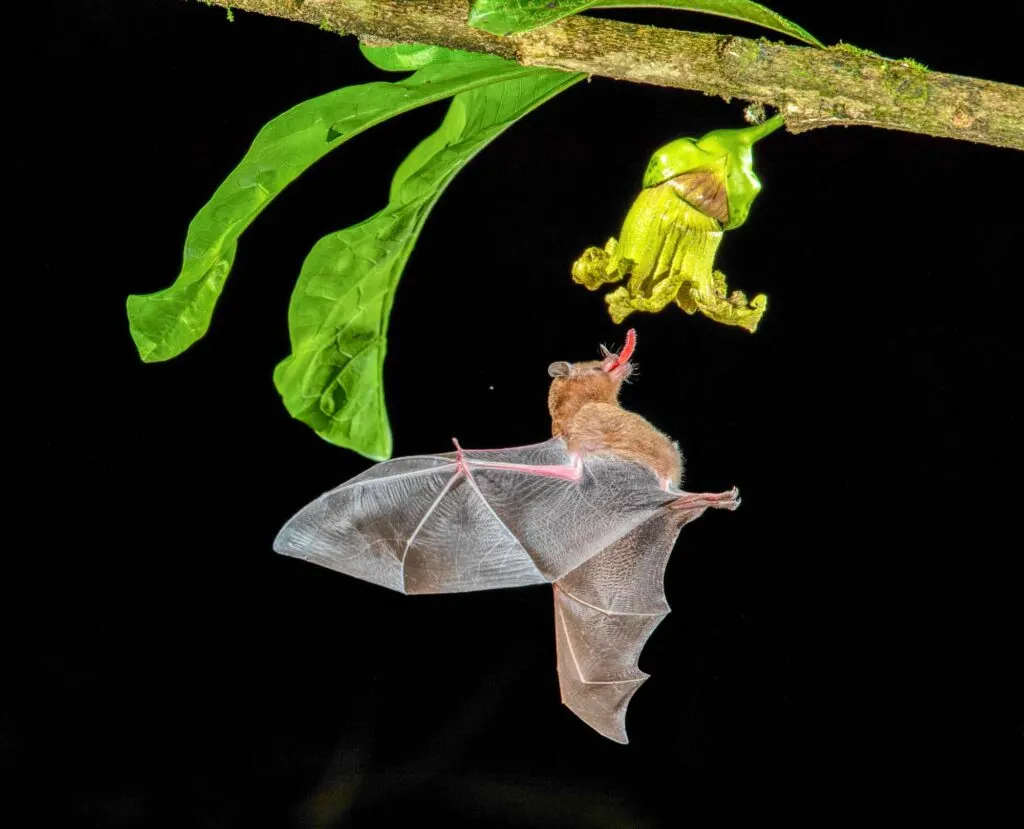
While this Amazon mammal is widespread in its range, it is considered locally rare, and it inhabits the Amazonian High- and Lowlands (Peru, Ecuador, Brazil, etc.).
This bat varies in its coloration throughout its range, from gray with a yellow cast dorsally with a gray/white venter to dark brown with a red cast and a yellowish venter.
Unlike the common vampire bat, the Brazilian brown bat is an insectivorous bat that has been known to feed over tropical streams in South American forests and can also be found feeding along edges of other habitats.
Beyond that, researchers determined the Brazilian brown bat does not roost in caves.
7. Brazilian tapir
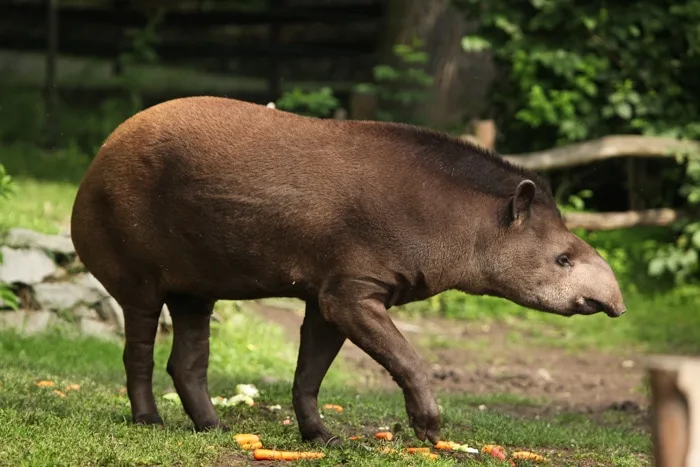
Brazilian tapir is a species of the rhinoceros family and was recognized as a separate species in 1758.
Newborn babies exhibit dappled spots on their bodies, which serve as ideal camouflage. These markings disappear by six months old, after which the young tapirs gain their adult appearance.
Brazilian tapirs generally lead a solitary lifestyle, except for the mating season, when they live in pairs and mothers with their young, who often travel together.
They are primarily nocturnal and usually spend daytime hours in shelters located around the forest. During the night, they leave their dens to seek food.
These Amazon mammals are herbivores (folivores and frugivores), and their diet is generally composed of plant material such as fruits, leaves, and buds.
Amazon facts: When facing a predator, the Brazilian tapir will flee and dive into the Amazonian rivers to protect itself.
8. Bush dog
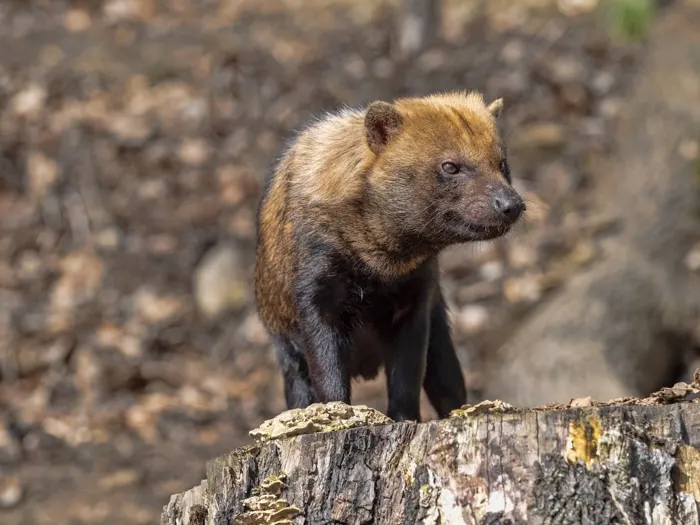
The Bush dog species is so rare that in the past, it was thought to be extinct. They were first discovered using fossil records in caves in Brazil, and, having never been seen before this, it was thought they no longer existed.
This Amazon Rainforest mammal species has a squat body with reddish-brown fur and is 22-29 feet long.
Curiously, bush dogs are monogamous and live in extended family groups. They prey primarily on large rodents, such as agoutis, capybaras, and rheas.
Illegal poaching and deforestation leading to habitat loss are the main threats to the bush dog population.
9. Amazon river dolphin

The Amazon River dolphin, also called the Boto or pink dolphin, is one of the five river dolphins and is treated with suspicion by local people.
In Brazilian culture, folk tales say these animals become handsome men to seduce young women into the water.
Although these mammal species say it is pink, its color varies with age. Newborns are usually dark gray, becoming light gray during adolescence, and pink as adults. Males are often pinker than females.
The pink river dolphins are the largest freshwater dolphins in the world.
Harmful tourism, water pollution, fishing, and ever-expanding lodging are some of the reasons these species of mammals are at risk of extinction, according to the IUCN.
Finally, the pink dolphins feed mainly from piranhas, river turtles, and crabs in the Amazonian Rainforest’s slow-moving rivers.
10. Giant anteater
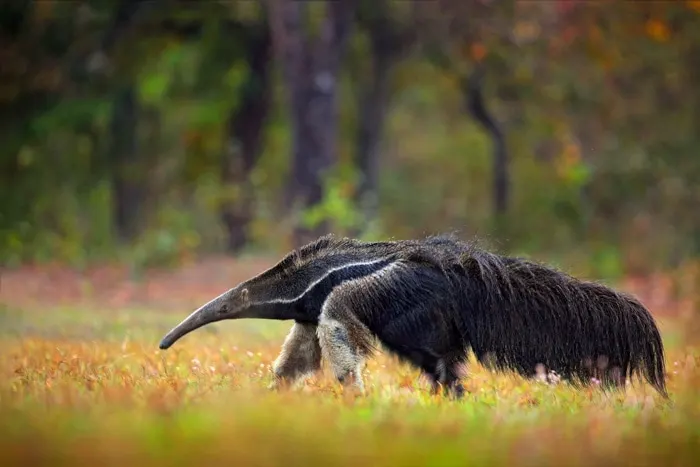
These big edentate animals swallow about 35,000 ants and termites every day. Beyond that, this Brazilian animal is not aggressive, but it can be fierce. It has 4 in/10 cm long claws and can fight off predators, such as the jaguar.
This Amazon Rainforest mammal has long, bushy tail and short, strong legs. The Giant anteater’s head is narrow and long, having a small, black snout on end.
Beyond that, the giant anteaters use their sharp claws to tear an opening into an anthill and flicks their long tongues into the whole up to 150 times per minute.
Because the ants fight back with painful stings, the anteaters only feast for about a minute before moving on. Also, they never destroy the nest, so they have a place to feed later.
Amazon facts: The giant anteater is a jungle mammal with no teeth.
11. Brown woolly monkey
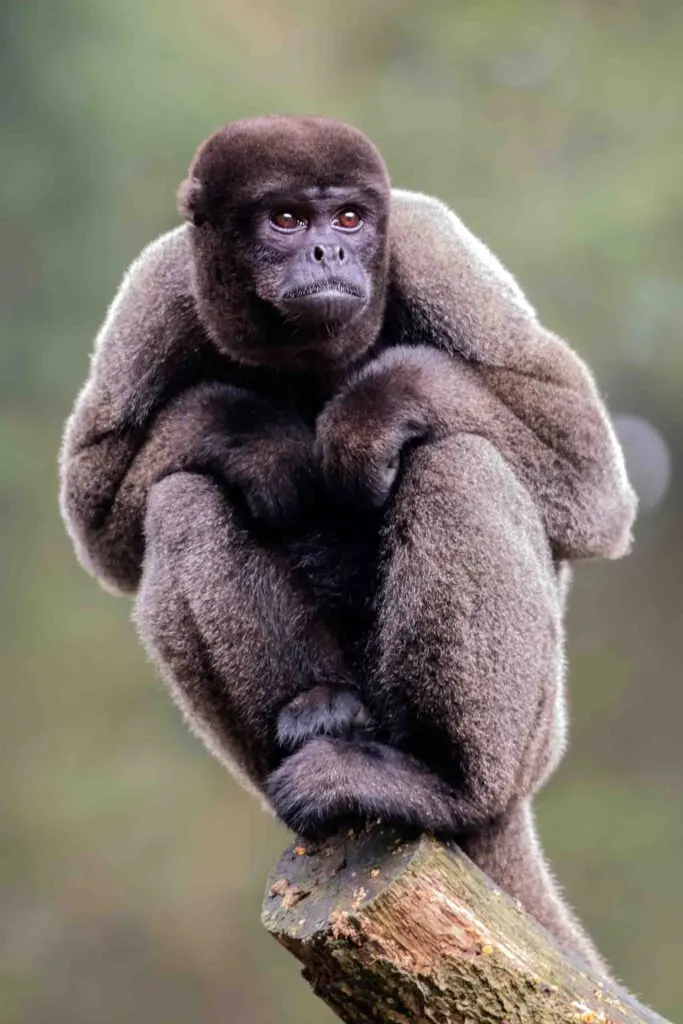
The Brown woolly is one of those mammals in the rainforest with a gray or black body contrary to its name.
Usually, this primate has a short soft thick fur, except on its face. It has a prehensile tail used to swing from branch to branch and long limbs, enable it to move quickly across the forest.
Males are usually larger when compared to females and typically live in groups of 2 to 70. The groups are further split down into two subgroups, mainly comprising of family members.
This Amazon mammal is arboreal, diurnal and typically uses all four legs when walking, running, or climbing. Their diet is mainly made up of several species of plants, insects, and small animals.
12. Brown-throated three-toed sloth
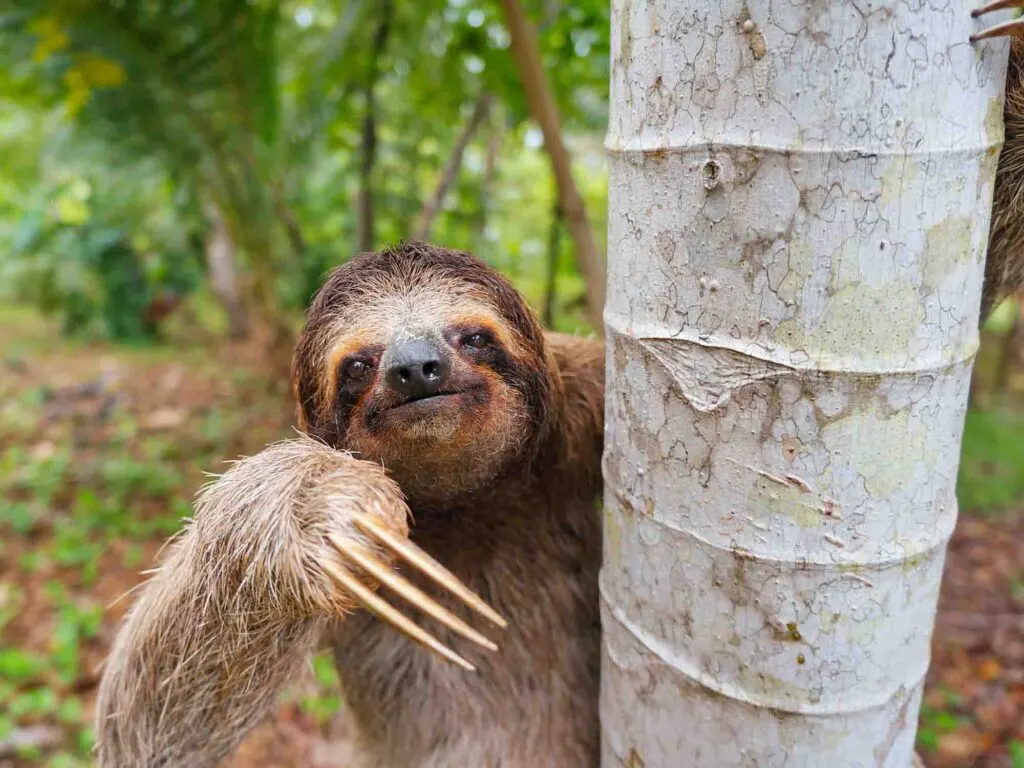
Also known as brown-throated sloth, the three-toed sloth is the slowest mammal in the world.
It moves through the canopy of Central and South America at a rate of about a whopping (not!) 40 yards (91 m) per day and spends between 15-20 hours per day sleeping.
Because they can hang onto branches with their long claws, these Amazon Rainforest mammals can feed on leaves found too high for other animals to reach.
On the other hand, these long claws make it very difficult for them to walk on the ground. For that reason, the Brown-throated three-toed sloths are primarily arboreal, living in trees.
How many mammals are there in the Amazon Rainforest?
The Amazon Rainforest has the most diverse biome in the Americas, let alone the world, and is home to more than 430 mammal species, most of which are rodents and bats.
Did you enjoy this article about the mammals of the Amazon Rainforest in South America? Then share it with a friend who might like it too!
